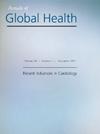卢旺达空气污染对心血管疾病造成的负担
IF 2.6
4区 医学
Q2 PUBLIC, ENVIRONMENTAL & OCCUPATIONAL HEALTH
引用次数: 0
摘要
背景:卢旺达与撒哈拉以南非洲的许多国家一样,仍处于相对较早的发展阶段。工业化和城市化是该国经济增长的主要动力。卢旺达也正在经历流行病学的转型,从以传染病为主的发病率和死亡率模式向以非传染性疾病(NCDs)为主的模式转变。非传染性疾病增加的部分原因是接触环境危害的机会越来越多。这包括日益增多的机动车辆排放的废气和有毒的职业接触。在卢旺达,心血管疾病 (CVD) 现在是一个越来越重要的死亡原因,而环境空气污染是一个越来越重要的心血管疾病风险因素。目标:量化卢旺达空气污染造成的心血管疾病负担,确定预防和控制空气污染及污染相关疾病的机会。方法:我们依据 2019 年全球疾病负担 (GBD) 研究,了解卢旺达家庭和环境空气污染的水平、来源和趋势,以及污染相关疾病的负担。有关污染源的信息来自健康影响研究所的《2019 年全球空气状况报告》。研究结果:据估计,2019 年卢旺达有 3477 例死亡(95% 不确定区间 [UI]:2500-4600 例)可归因于与空气污染相关的心血管疾病。其中,689 例死亡(UI:283-1,300 例)与环境空气污染相关的心血管疾病有关,2,788 例死亡(UI:1,800-3,800 例)与家庭空气污染相关的心血管疾病有关。结论:随着卢旺达经济的发展,包括心血管疾病在内的非传染性疾病的发病率和过早死亡率都在上升。虽然家庭空气污染仍是导致疾病和过早死亡的首要污染相关原因,但环境空气污染水平的上升已成为一个日益重要的心血管疾病风险因素。建议:现在采取行动遏制环境空气污染水平的上升,将改善健康状况,减少心血管疾病,延长寿命,并为卢旺达带来巨大的经济效益。应对空气污染最有效的措施是在全国范围内迅速过渡到可再生能源。此外,我们还建议卢旺达将空气污染预防和控制作为优先事项,建立一个强大的全国性空气监测网络,支持空气污染物对健康影响的研究,并建设国家研究能力。为城乡公共卫生和医疗保健分配更多资源将对空气污染控制措施起到补充作用,并进一步减少心血管疾病。为了激励卢旺达和其他国家迅速向可再生能源过渡,我们建议设立一个新的全球绿色发展基金。本文章由计算机程序翻译,如有差异,请以英文原文为准。
The Burden of Cardiovascular Disease from Air Pollution in Rwanda
Background: Rwanda, like many countries in sub-Saharan Africa, is still relatively early in development. Industrialization and urbanization are major drivers of the county’s economic growth. Rwanda is also undergoing an epidemiological transition, from a pattern of morbidity and mortality dominated by infectious diseases to a pattern shaped by non-communicable diseases (NCDs). The rise in NCDs is due, in part, to increasing exposures to environmental hazards. These include emissions from the growing number of motor vehicles and toxic occupational exposures. Cardiovascular disease (CVD) is now an increasingly important cause of death in Rwanda, and ambient air pollution is a CVD risk factor of growing importance. Objectives: To quantify the burden of CVD attributable to air pollution in Rwanda and identify opportunities for prevention and control of air pollution and pollution-related disease. Methods: We relied on the 2019 Global Burden of Disease (GBD) study for information on levels, sources, and trends in household and ambient air pollution and the burden of pollution-related disease in Rwanda. Information on pollution sources was obtained from the Health Effects Institute State of Global Air 2019 report. Findings: An estimated 3,477 deaths (95% Uncertainty Interval [UI]: 2,500–4,600) in Rwanda in 2019 were attributable to air pollution-related CVD. Of these, 689 (UI: 283–1,300) deaths were from ambient air pollution-related CVD, while 2,788 (UI: 1,800–3,800) deaths were from household air pollution-related CVD. Conclusion: Rwanda is experiencing increased rates of disease and premature death from NCDs, including CVD, as the country grows economically. While household air pollution is still the top pollution-related cause of disease and premature death, rising levels of ambient air pollution are an increasingly important CVD risk factor. Recommendation: Actions taken now to curb rising levels of ambient air pollution will improve health, reduce CVD, increase longevity, and produce great economic benefit for Rwanda. The single most effective intervention against air pollution will be a rapid nationwide transition to renewable energy. We recommend additionally that Rwanda prioritize air pollution prevention and control, establish a robust, nationwide air monitoring network, support research on the health effects of air pollutants, and build national research capacity. The allocation of increased resources for rural and urban public health and health care will complement air pollution control measures and further reduce CVD. To incentivize a rapid transition to renewable energy in Rwanda and other nations, we recommend the creation of a new Global Green Development Fund.
求助全文
通过发布文献求助,成功后即可免费获取论文全文。
去求助
来源期刊

Annals of Global Health
PUBLIC, ENVIRONMENTAL & OCCUPATIONAL HEALTH-
CiteScore
5.30
自引率
3.40%
发文量
95
审稿时长
11 weeks
期刊介绍:
ANNALS OF GLOBAL HEALTH is a peer-reviewed, open access journal focused on global health. The journal’s mission is to advance and disseminate knowledge of global health. Its goals are improve the health and well-being of all people, advance health equity and promote wise stewardship of the earth’s environment.
The journal is published by the Boston College Global Public Health Program. It was founded in 1934 by the Icahn School of Medicine at Mount Sinai as the Mount Sinai Journal of Medicine. It is a partner journal of the Consortium of Universities for Global Health.
 求助内容:
求助内容: 应助结果提醒方式:
应助结果提醒方式:


